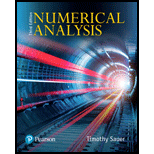
Concept explainers
Apply the Adams-Bashforth Two-Step Method to the IVPs
with initial condition
a.
To find: the solution for the given IVPs problem for given step.
Explanation of Solution
Concept used:
Dr.Heun refer to an improved or modified Euler method (that is, an explicit trapezoidal rule)." from this it can be understood that the idea of an explicit trapezoidal rule is to replace the correct selection element on the right side with numerical approximation problems solution.
Calculation:
From this theorem known that using the Explicit Trapezoid Method with
For the remainder of the steps, we apply the Adams-Bash forth Two-Step Method, which is
Therefore
Global error at
b.
To find: the solution for the given IVPs problem for given step.
Explanation of Solution
Concept Used:
Dr.Heun refer to an improved or modified Euler method (that is, an explicit trapezoidal rule)." from this it can be understood that the idea of an explicit trapezoidal rule is to replace the correct selection element on the right side with numerical approximation problems solution.
Calculation:
From this theorem known that using the Explicit Trapezoid Method with
The Adams-Bash forth Two-Step Method is
Completing the last three steps results in the following table:
Global error at
c.
To find: the solution for the given IVPs problem for given step.
Explanation of Solution
Concept Used:
Dr.Heun refer to an improved or modified Euler method (that is, an explicit trapezoidal rule)." from this it can be understood that the idea of an explicit trapezoidal rule is to replace the correct selection element on the right side with numerical approximation problems solution.
Calculation:
From this theorem known that using the Explicit Trapezoid Method with
The Adams-Bash forth approximation
Global error at
d.
To find: the solution for the given IVPs problem for given step.
Explanation of Solution
Concept used:
Dr.Heun refer to an improved or modified Euler method (that is, an explicit trapezoidal rule)." from this it can be understood that the idea of an explicit trapezoidal rule is to replace the correct selection element on the right side with numerical approximation problems solution.
Calculation:
From this theorem known that using the Explicit Trapezoid Method with
The Adams-Bash forth approximation
Global error at
e.
To find: the solution for the given IVPs problem for given step.
Explanation of Solution
Concept used:
Dr.Heun refer to an improved or modified Euler method (that is, an explicit trapezoidal rule)." from this it can be understood that the idea of an explicit trapezoidal rule is to replace the correct selection element on the right side with numerical approximation problems solution.
Calculation:
From this theorem known that using the Explicit Trapezoid Method with
The Adams-Bash forth approximation
Global error at
f.
To find: the solution for the given IVPs problem for given step.
Explanation of Solution
Concept used:
Dr.Heun refer to an improved or modified Euler method (that is, an explicit trapezoidal rule)." from this it can be understood that the idea of an explicit trapezoidal rule is to replace the correct selection element on the right side with numerical approximation problems solution.
Calculation:
From this theorem known that using the Explicit Trapezoid Method with
The Adams-Bash forth approximation
Global error at
Want to see more full solutions like this?
Chapter 6 Solutions
Numerical Analysis
- Can you help explain what I did based on partial fractions decomposition?arrow_forwardFind the surface area of the regular pyramid. yd2arrow_forwardSuppose that a particle moves along a straight line with velocity v (t) = 62t, where 0 < t <3 (v(t) in meters per second, t in seconds). Find the displacement d (t) at time t and the displacement up to t = 3. d(t) ds = ["v (s) da = { The displacement up to t = 3 is d(3)- meters.arrow_forward
- Let f (x) = x², a 3, and b = = 4. Answer exactly. a. Find the average value fave of f between a and b. fave b. Find a point c where f (c) = fave. Enter only one of the possible values for c. c=arrow_forwardThe following data represent total ventilation measured in liters of air per minute per square meter of body area for two independent (and randomly chosen) samples. Analyze these data using the appropriate non-parametric hypothesis testarrow_forwardeach column represents before & after measurements on the same individual. Analyze with the appropriate non-parametric hypothesis test for a paired design.arrow_forward
- Should you be confident in applying your regression equation to estimate the heart rate of a python at 35°C? Why or why not?arrow_forwardGiven your fitted regression line, what would be the residual for snake #5 (10 C)?arrow_forwardCalculate the 95% confidence interval around your estimate of r using Fisher’s z-transformation. In your final answer, make sure to back-transform to the original units.arrow_forward
 College Algebra (MindTap Course List)AlgebraISBN:9781305652231Author:R. David Gustafson, Jeff HughesPublisher:Cengage LearningAlgebra & Trigonometry with Analytic GeometryAlgebraISBN:9781133382119Author:SwokowskiPublisher:Cengage
College Algebra (MindTap Course List)AlgebraISBN:9781305652231Author:R. David Gustafson, Jeff HughesPublisher:Cengage LearningAlgebra & Trigonometry with Analytic GeometryAlgebraISBN:9781133382119Author:SwokowskiPublisher:Cengage

 Trigonometry (MindTap Course List)TrigonometryISBN:9781337278461Author:Ron LarsonPublisher:Cengage Learning
Trigonometry (MindTap Course List)TrigonometryISBN:9781337278461Author:Ron LarsonPublisher:Cengage Learning Functions and Change: A Modeling Approach to Coll...AlgebraISBN:9781337111348Author:Bruce Crauder, Benny Evans, Alan NoellPublisher:Cengage Learning
Functions and Change: A Modeling Approach to Coll...AlgebraISBN:9781337111348Author:Bruce Crauder, Benny Evans, Alan NoellPublisher:Cengage Learning





